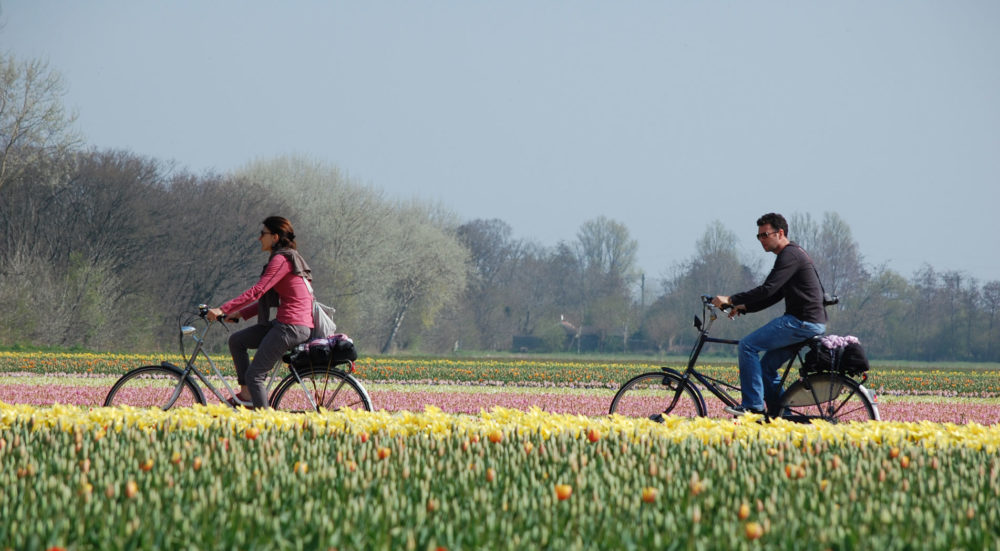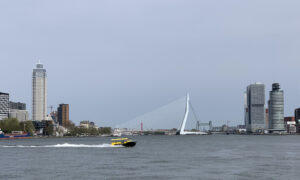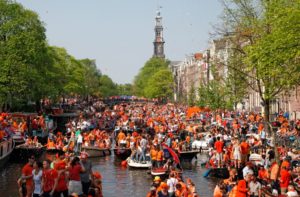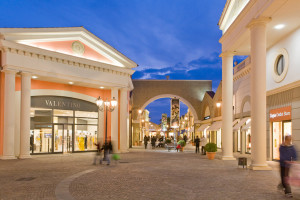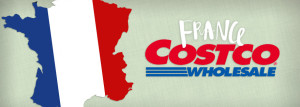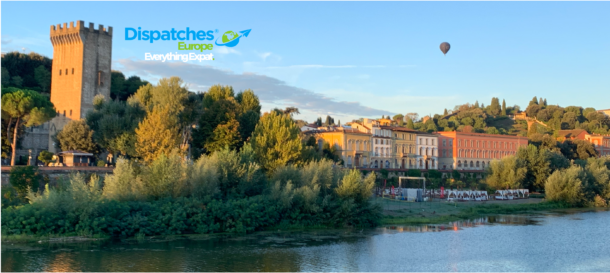You’ve just arrived in the Netherlands or Denmark and can’t wait to try the national passions for cycling … to hop on a bike and explore your new country.
But what are the rules and requirements for cyclists? Do you need to wear a helmet and can you cycle after you have had a few beers?
We’re here for you with our complete guide to cycling in Denmark and the Netherlands. Here is all you need to know!
Do as the locals do and embrace the cycling culture in Europe. Hop on your bike for a quick trip to the store, to get to work or to do some sightseeing around the country. Here is our guide to cycling in the Netherlands and Denmark, two of the most bike-friendly countries in the world. Get yourself a good bike and get ready to peddle your way through expat life in Europe.
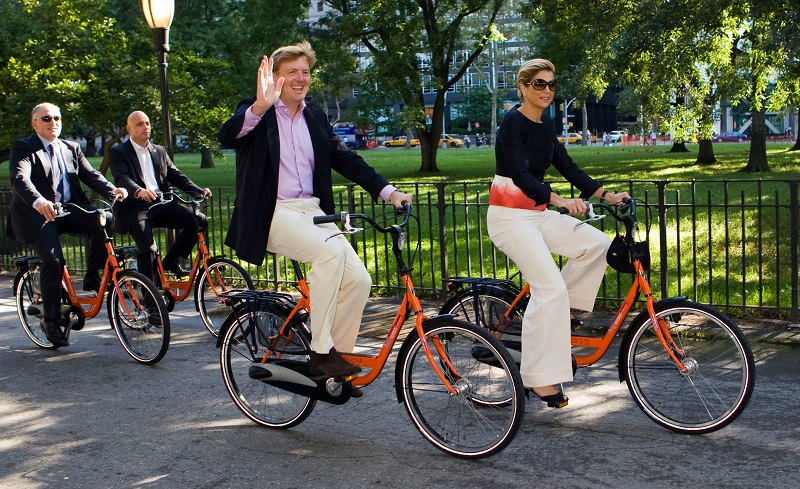
EVERYONE IN THE NETHERLANDS RIDES INCLUDING KING WILLEM-ALEXANDER AND QUEEN MÁXIMA. AND YES, THE GUYS BEHIND THEM ARE SECURITY.
Cycling in the Netherlands
Dutch people have been cycling since they were old enough to walk and fearlessly make their way through busy streets and traffic. Cycling with a child or friend on the back after a few glasses of wine, or while making a phone call … when you first move to the Netherlands it may seem like there are no rules at all.
This is not entirely true. There are a few rules you need to know to keep in mind when you start cycling in the Netherlands.
First of all: make sure you have the right equipment. If you are cycling at night, you must have lights on the front and back of your bike. Every bike also needs to have reflectors on the back, on the pedals and on the wheel, a working bell and brakes.
Helmets are not mandatory and not very common for commuters in the Netherlands. The exceptions are competitive bikers in clubs and mountain bikers taking on off-road trails.
On to the rules:
- The basics are very simple: As a cyclist, you follow the same rules as motor vehicle drivers, but you use the bike lanes. The Netherlands has a large network of bike lanes which are usually red. If there is no bike lane, you can use the road. In some cities, such as Eindhoven, there are even special bike roundabouts that allow cyclists to ride safely above busy auto intersections.
- Make sure to give right of way to buses and trams. Signal by putting out your arm when you turn left or right.
- Cycling next to a friend is fine as well as sitting on the back of someone else’s bike. But you can’t block traffic. So you might have to ride single-file sometimes.
- Cyclists are allowed to turn right at a red traffic light if there is a sign that reads: “rechtsaf voor fietser vrij” (literally, “Right turn for bikes free.”).
- If you are carrying a child younger than eight, you are required to get a special bike seat that you attach to your cycle rack.
There are a few other things to watch out for. While many Dutch people chose to cycle home after a night out, you are not actually allowed to get on a bike after you have had some drinks.
When it comes to alcohol and drugs, the same rules apply for cyclists and drivers.
Using your phone to text or call while you are cycling is not yet forbidden, but this likely will change in the near future.
Finally, if you would like to take your bike with you on the train, you can. Just make sure you travel outside of rush hours (on weekdays, you can’t take your bike on a train before 9 a.m. and between 4 p.m. and 6.30 p.m.) and get a special ticket on top of your own train ticket.
Folding bikes are the only exception; you can take these bikes with you any time at no extra cost.

IN COPENHAGEN, CHRISTIANIA BIKES FUNCTION AS PICKUPS. (Photo by Ivana Avramovic for Dispatches)
Cycling in Copenhagen and beyond
Copenhagen has more bikes than cars and everyone here loves to cycle, just like in the Netherlands. When it comes to the right equipment, the Danish rules are similar to the Dutch.
- Make sure your bike has a working bell and brakes, a white light on the front and a red one on the back, a white reflector on the front, yellow reflectors on the pedals and wheels and a red reflector on the back.
- You will find plenty of bike lanes in Denmark and if not, stay on the right side of the road.
- Use your arms to signal when you are slowing down, stopping or turning.
- Unlike in the Netherlands, you are not allowed to carry another person on your bike unless it is a child in a child seat.
- Helmets are not mandatory.
- Using your phone while cycling is already illegal in Denmark and can get you a costly fine.
- The same goes for drunk cycling.
If you stick to the rules, you will find that Denmark is a fantastic place for cyclists. Not only is cycling cheaper, healthier and better for the environment than driving, it is often a whole lot quicker.
Thanks to the many bike lanes, you can quickly make your way through a city and the green waves in Copenhagen make your journey even more enjoyable. The traffic signals in Denmark’s capital have been adjusted to favor cyclists so you can ride a green wave through the city.
When riding your bike in winter, you don’t have to be afraid of slippery bike lines. City policy states that bike lanes should be cleared of snow first, before other roads – with the exception of the main car roads which are cleared of snow at the same time as the bike lanes!
Big no-nos in Copenhagen
Not surprisingly, Copenhagen has more rules – and more strictly enforced – than the Netherlands, which is fairly libertarian. These are the violations that will get you a hefty fine, according to our expats.
• Going the wrong direction on a one-way street.
• Failing to use your lights from sunset to sunrise.
• Bikes must stop for traffic signals, or a when a bus’s doors are open. If passengers exit into the bike lane, cyclists need to stop and wait until the bus departs.
• Using a cellphone phone while cycling.
• Riding in ‘no cycling’ zone.
• Biking through pedestrian crossings instead of walking it across the street.
• Speeding (there’s a bike speed limit in some places in the center of Copenhagen. No, really.)
Copenhagen has so many rules we can’t really include them all. But here’s a handy list to review before you hit the road.
 About the author:
About the author:
About the author: Willeke van Doorn is a Dutch journalist and graduate of Fontys University of Applied Sciences in Tilburg, Netherlands.
Her experience includes an internship at National Geographic Traveler in Amsterdam. But she began her professional career at Dispatches Europe. She now works in Germany.
Willeke has lived in the U.S. and Australia and loves to travel the world.
Here are some of Willeke’s recent posts:
A working holiday visa allows some non-EU citizens to work while traveling across Europe
Willeke van Doorn: Backpacking in Australia had me doing things I never knew I could do


